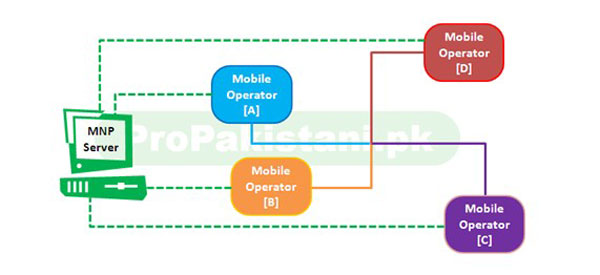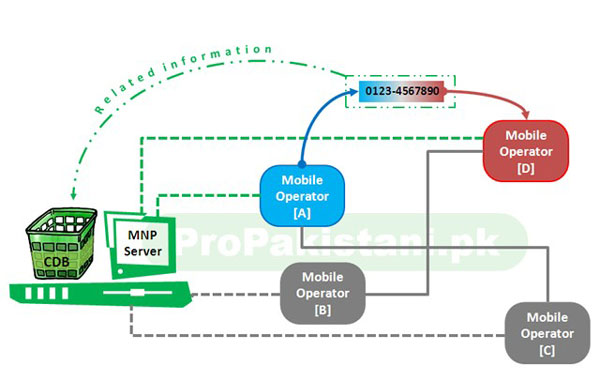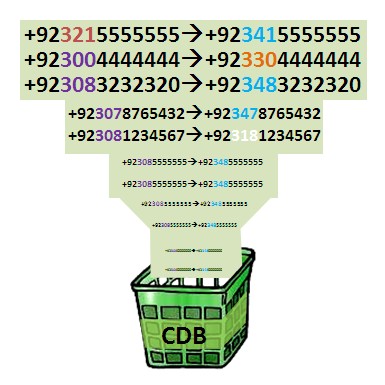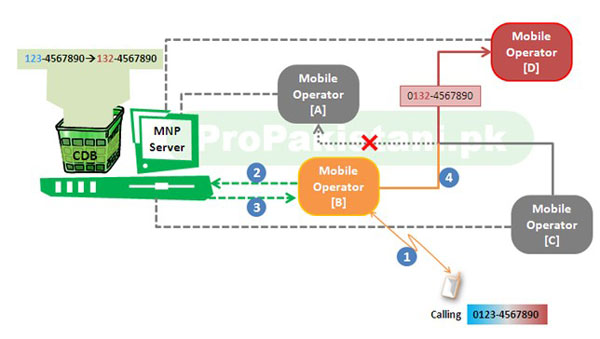Mobile Number Portability, or MNP as we all know it, allows a mobile phone user to switch to a new operator (recipient) and avail its services while still retaining his old-operator (donor) number.
Number portability is always a state/regulatory-body implementation which keeps accord among the network operators participating in it.
In Pakistan, all the five GSM, AMPS and landline network operators participate in the MNP, which is as said, Government harmonized. In Pakistan, MNP system is managed by Telcordia Technologies (a company emerging from the famous Bell Systems Ltd.)
Yes, the word ‘System’ here indicates the existence of a physical entity or rather a software solution linking several vital bodies. Leaving aside all the technical terms and jargons; in most simple manner, the link architecture for a MNP-Server (as we will call it) can be drawn as:
The server is accessible to all networks and its main functions are to maintain a database record of the ported numbers, and to assist the networks in routing the incoming traffic (voice and text). This is basically done by maintaining a memory basket, technically called ‘Central DataBase (CDB)’ of the ported numbers.
Whenever a number is ported from a network to another, a set of associated information is stored in the CDB, which is then accessible to all the other networks as well.
To understand how MNP works, one must know what ‘Related Information’ is transferred to the CDB when a number is ported. Not going into deep details; there are a couple of terms that must be known i.e.
- IMSI
- MSISDN
- ICC-ID
- SIM
A SIM, as most of us know, stands for ‘Subscriber Identity Module’. Generally, it is reflected of as a card that holds the subscriber’s mobile number. Actually it doesn’t. SIM basically holds the IMSI (International mobile subscriber identity). An IMSI is a 14-digit number that uniquely indicates presence of a SIM card.
No two SIMs in the world would have the same IMSI. Your mobile number, or MSISDN (Mobile Subscriber Integrated Services Digital Network) as it is technically known is mapped against the IMSI and the map is known by the SIM issuing network operator. The mobile numbers we use (e.g. 0300-1234567) are illusive by nature; a cell phone uses the IMSI to communicate with its parent network.
ICC-ID (Integrated circuit card ID) is a 19 digit number that signifies the physical existence of a SIM card and acts more like a product serial number. It is hard-written and dies with the SIM. The ICC is just like the IMEI code of a mobile instrument and is printed on back of the SIM as well.
To clear things up a bit, try to understand the scenario using an analogy:
- The ICC-ID is your NIC number. Unique for everyone. Never to be used again for anybody else.
- IMSI is your university’s ID number/roll number.
- And the MSISDN (the phone number) is your name.
You use your name [MSISDN or the phone number] in your everyday communication. Which by itself cant be unique, but combining it with your sir-name and address will make it distinctive. Like your mobile number combined with network code and country code is unique across the world.
However your university (a network you are a part of) still uses your roll number in all the official settlements (which may or may not be accompanied with your name). Why not the name itself? You can figure it out yourself. Other universities (other networks) on the other hand will still use your name + sir-name + address for referring you, not your roll number.
I shall explain it by the example of losing your SIM. If you ever had lost one, you are issued a new SIM with your old number. The operating company simply de-maps your MSISDN off your lost SIM’s IMSI and maps it against a new IMSI. So you shall have a new SIM, but old number. Similar is the case with a university re-admission case. If a student previously expelled is granted a new admission, he is allocated a new roll number, but the name still remains the same.
Back to the MNP . . .
Now, one might predict that MNP is as simple as it looks. De-mapping the IMSI off the donor operator’s IMSI and mapping it against the recipient’s. But the problem is that the IMSI and MSISDN are network dependent and cant be cross mapped.
Solution ?
The recipient operator selects an unregistered number out of its lot and dedicates it for the incoming port. Like, if a number 0313-5559555 is to be ported out, the recipient might select (if available) a similar looking number with its own network code. For instance: 0331-5559555. This number co-relation information (+923135559555 -> +923315559555) along with the new IMSI and ICC-ID is stored in the CDB unit of the MNP-Server.
The database, as earlier stated is then accessible to all the networks so the incoming traffic can be routed to the new number.
After the nation-wide implementation of MNP, every network first queries the MNP-Server before establishing a call so that it can know to what number and network the call must be routed. MNP in short, establishes a user-transparent call divert service, but without using the donor operator’s resources.
Consider the case of number ported from operator [A] to operator [D] as explained in figure-2. Now if a user of operator [B] will call that ported number, the call shall be routed as shown in the figure below.
Mobile operator [B] will first query the MNP server about the status of the number to be dialed. Since the number is ported, the server shall reply with a divert number. The call will therefore be routed to the recipient network, the Operator [D].
In case a called number is not ported, the MNP server shall not respond an affirmative nod, and normal call routing shall take place.





























Like
It can a taught in form of a lecture in some uni :)
very simple n easy to understand.
complicated… but thanx for such a good post…really informative…
Saad Chdry! What happens if a ported out number is again ported in to it’s previous (actual) network? Can a ported out number car retain it’s previous status or it’ll remain a ported number forever?
Theoratically, yes. The number shall retain its previous status. You shall get a new sim from your previous operator just like getting a sim if u had lost ur previous 1.
According to your description,there need to be status change of that number updated at central data base. Is CDB contacted for all the numbers? What about if there is local copy of CDB maintained at each network operator and it gets regular updated from centralized CDB. This way there will be communication between central data base and operator network only for numbers that are ported.
And please, tell us about the possible problems a ported number can bear. I want to mention one problem that when somebody calls from Ufone to a ported number, call timer starts immediately, even if call isn’t received. Along with, there should be a system by which a caller should know while calling that which number is ported to which network!
Possible problems . . . could be many.
I have ported my number recently. But i am still getting advertisments from my previous operator. The advert SMSs get diverted to my ported number as well …Funny.
U, as a end user cannot know what network ull be calling. However there are a number of clues u can predict ur friend’s operator:
>> Try recognizing the automatic recordings that are played when the number u r calling is Busy, Off, or Not-responding etc. Every network has different recordings.
>> If u have a nokia, u can easily see the SMS centre number of the sender . . . usually displayed in the end of a received msg. U will recognize the operator using the first 3 digits (the network code) of the msg centre #.:D
thanks for this useful information.
maine b port change ki thi aur ye meri sub se badi galti the. ab mera number bilkul ese hai jese courpt Windows.
Very informative with easy understanding. Keep it up Saad (Y).
Thnx ATM :-*
one problem with ported numbers, specially with numbers originally issued by mobilink, is that if you forget to tell the easyload retailer that your number is ported to operator X (i.e. he uses mobilink sim to send easyload request instead of X) then mobilink will just eat up your amount (instead of sending an error back that this number does not belong to mobilink). So always be carefull when asking for easyload (specially when your number was originally issued by mobilink which sucs :-) )
Ported numbers koo complete process main kuch TIME Required hota hai… main ne JAZZ ka # MNP karwaya thaa kuch Days Problem hoee thee thn theek hoo gaya.
MNP is good but i think anyone use it if it is most important to transfer network, bcoz many friends of mine facing problems specially when anyone call them they found no. in no use or busy or call dont convey to mnp number.
But its your choice do as you like.
A 0 A! main ne Telenor ka # ZONG par Port-in karwana tha, MNP ki Request send karta hoon tuu TELENOR ki Taraf se ICCID & Required Information ki jaga Package Plans Batayey jatey hain, Again & Again Help Line call karney par bhee faida nahee hoa Yey Problem Merey 1 Friend k sath bhee hai… TELENOR Mnp karwaney waley Costumers koo ziada Tang kar raha hai… baat St right hai.. jiss kooo jo Network theek lagey wo us par chala jaey… is Tarhan sey Tang karna tuu theek nahee na??? TELENOR Walon ko is Problem ko Solve karna chayey!
Since most of the marketing/sales department at telco’s are a little slow on the uptakes, here’s a piece of FREE advise:
For MNP subscribers, provide the “hidden” telco specific number as well!! This way you can ensure when the MNP service is down (which it has been on a number of days) the subscriber does NOT ponder on going back to the original telco. Its a win-win situation.
And for anyone working in a telco with a decent analytical mind (endangered species) would know, MNP subscribers have a high ARPU – so you want to hold onto them!!
There is no doubt MNP is succesfull way to entertain the custumers by PTA along this pacakge
donor mobile oprators to maint the servises best to custumers because other wise he switch over to opther network but at this stage MNP remains to required some updates and take desicion on rejection
THERE IS BIG CONCERN OF CALL CHARGING MATTER
if a ufone 0333-123456 no which is ported to mobilink jazz.
when i call 0333-123456 it apears as ufone no but is at jazz since it was ported,
if i make a 10 min call. will i be charged for ufone to ufone on net call charges.
or
off net ufoen to mobilink jazz charges.
since the diffrence is the no is ufone to ufone but network wise it is ufone to jazz
if someone dont know it is ported no, he maybe happy that he is paying on net charges of same network no. but unknouwingly being charged off net charges of higher amount since no maybe of same network but , since ported its no is same of ufone but acual network jazz.
very confusing and there is no information given for this regard of CHARGING, since this will litteraly eat our BANALCE, MONEY,
please anyone with credible, genuine, confirmed, reliable, imformation answer this, please avoid gurssigs, and thinkings.
ALLAH HAFIZ O NASIR
as salam walaikum
I have a question that the procedure for mobile number porting is same for 3GPP and 3GPP2?
If not then what are the differences??
Plz elaborate..
i have some queries….
1. who is maintaining this MNP server?? PTA??
2. isn’t it a cause of call connectivity delay as for every call operator has to first check from MNP server and then it routes the call.
3. what if the operator doesn’t have a similar number for number co-relation?